Conductor Rafael Frühbeck de Burgos. Photograph courtesy of the National Symphony Orchestra
After a gala celebration with music director Christoph Eschenbach on Sunday night, the National Symphony Orchestra went back to work this week. The first subscription concert reunited the orchestra with an old friend, frequent guest conductor Rafael Frühbeck de Burgos, returning to the podium of the Kennedy Center Concert Hall for the first time since 2010. The Spanish conductor has had a journeyman sort of career, distinguishing himself with guest appearances and chief conductor stints with many orchestras around the world: Musical America recognized his accomplishments this year by naming him conductor of the year. The NSO musicians always seem at ease under his baton (Frühbeck de Burgos was principal guest conductor of the NSO in the 1980s and has been a regular ever since), and he led interpretations of two orchestral staples—Beethoven’s slender, vivacious eighth symphony and Carl Orff’s salacious, bubbly Carmina Burana—that were polished and full of surprises.
Of Beethoven’s nine symphonies, the modest eighth is low on the totem pole in terms of popularity, and this was the NSO’s first performance of the work since 2002. Frühbeck de Burgos led an assured performance that highlighted much of the work’s appeal, especially in the first movement, with well-paced rallentandi helping to elucidate the formal structure, and the timpani and brass adding brash highlights in loud passages. The second movement, Allegro scherzando, had a pleasing, relaxed tempo, but always with a solid internal pulse and elegant dynamic shaping. Only in the third movement did the impetus droop slightly, with some strident sounds from the high woodwinds; and some unsettled tempo disagreements across the orchestra addled the slightly manic fourth movement.
Even if you’ve never been to a symphony concert in your life, you know the first movement of Orff’s Carmina Burana from countless adventure and fantasy movies. Orff, working in Germany in the early years of the Third Reich, conceived the work as a staged sort of oratorio, compiling the libretto from selections of the vast corpus of poetry—learned and low, sacred and profane, exalted and ribald, in Latin, Old German, and Provençal—in the medieval Codex Buranus, preserved by the monks of Benediktbeuern Abbey in Bavaria. These days, it’s almost always performed solely as a concert work, and this performance—bringing together the assembled masses of the Choral Arts Society of Washington, the Children’s Chorus of Washington, and three vocal soloists—hits all the right marks, showing in its dramatic scope why the piece has remained so popular. If you’ve been waiting for a good excuse to try out the NSO for yourself, this is the week.
Frühbeck de Burgos kept the audience guessing, choosing some unexpected tempi, either faster or slower than usual, and creating admirable variation in the strophic repeats of many movements. He drew subtle performances from these large, often unwieldy forces, although in some places it was like dragging an elephant, with the stacked rows of choristers not able to respond with flexibility. This was in contrast to the orchestra-only dance movements, which were lithe and malleable. Some of the fast or free tempi obfuscated the text, a problem that plagued the performance of the baritone soloist, Hugh Russell. He had the needed howl in his voice, although his dramatic sense did stray occasionally into the overly hammy, and his falsetto in Dies, nox et omnia was demure and almost feminine. Tenor Nicholas Phan, known primarily as an early music specialist, had a star turn as the roasting swan in Olim lacus colueram, with an anguished wail on the very high notes. The only disappointment was soprano Laura Claycomb, whose intonation was too often a little to the flat side. It was a pretty voice, but with a swallowed, contained tone, leaving one wishing for a more orgasmic sigh kind of sound in the Dulcissime exclamation. The best choral moment was the highlight of the In taberna section, the drinking song of the lusty male chorus, which sang with precision and vocal abandon.
This concert will be repeated tonight and Saturday evening (September 30 and October 1, 8 PM), in the Kennedy Center Concert Hall. Tickets: $20 to $85.
















